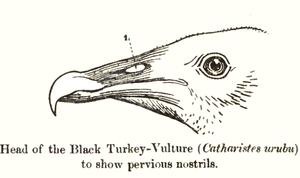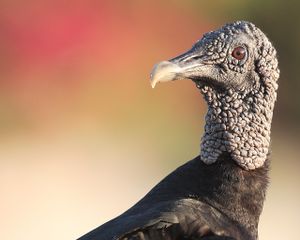عقاب العالم الجديد
| عقاب العالم الجديد New World vultures | |
|---|---|
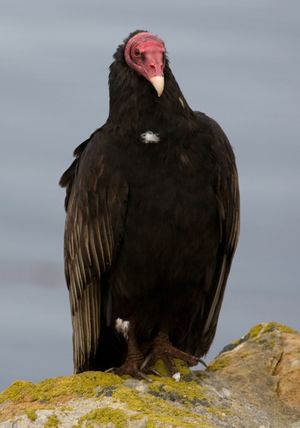
| |
| العقاب التركي | |
| التصنيف العلمي | |
| مملكة: | |
| Phylum: | |
| Subphylum: | |
| Superclass: | |
| Class: | |
| Order: | Cathartiformes
|
| Family: | Cathartidae لافرسنياي، 1839
|
| الأجناس | |
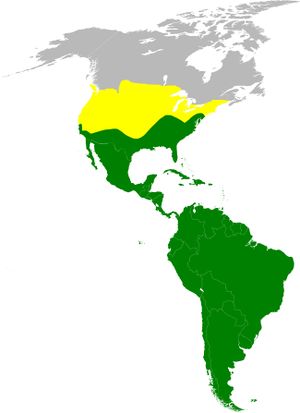
| |
| نطاق انتشار عقاب العالم الجديد الأصفر-انتشار العقاب التركي في الصيف فقط | |
عقاب العالم الجديد أو الكوندور condor، هو فصيلت من الطيور تضم سبعة أنواع في خمس أجناس، جميعها عدا واحدة monotypic. وتتضمن خمسة عقابات وإثنين من الكوندور ينتشرون في المناطق الدافئة والمعتدلة من الأمريكتين. عقاب "العالم الجديد" كانت منتشرة في العالم القديم وأمريكا الشمالية في العصر النيوجيني.
إن فصيلة عقاب العالم الجديد ليست قريبة جينياً من الفصيلة الفرعية: عقاب العالم القديم التي تدرج تحت فصيلة البازية، مع وجود تشابه ظاهري كبير بين الفصيلتين.
إن العقاب طيور منظفة، أي تقتات على الجيف وجثث الحيوانات الميتة بشكل عام، ولنسور العالم الجديد حاسة شم قوية، أما نسور العالم القديم فتعثر على الجيف مستخدمة حاسة البصر، والسمة العامة التي يمتاز بها كثيرٌ من النسور هي الرأس الأصلع الخالي من الريش.
. . . . . . . . . . . . . . . . . . . . . . . . . . . . . . . . . . . . . . . . . . . . . . . . . . . . . . . . . . . . . . . . . . . . . . . . . . . . . . . . . . . . . . . . . . . . . . . . . . . . . . . . . . . . . . . . . . . . . . . . . . . . . . . . . . . . . . . . . . . . . . . . . . . . . . . . . . . . . . . . . . . . . . . .
التصنيف
الأنواع الموجودة
- جنس Coragyps
- العقاب الأسود Coragyps atratus في أمريكا الجنوبية والشمالية حتى الولايات المتحدة
- جنس Cathartes
- العقاب التركي Cathartes aura عبر الأمريكتين حتى جنوب كندا
- عقاب أصغر أصفر الرأس Cathartes burrovianus في أمريكا الجنوبية والشمالية حتى المكسيك
- عقاب أكبر أصفر الرأس Cathartes melambrotus في حوض الأمازون حتى أمريكا الجنوبية الإستوائية
- جنسGymnogyps
- كوندور كاليفورنيا Gymnogyps californianus في كاليفورنيا. كان في السابق منتشراً في جبال غرب أمريكا الشمالية.[1]
- Genus Vultur
- كوندور الأنيدز Vultur gryphus في الأنديز[2]
- جنس Sarcoramphus
- العقاب الملك Sarcoramphus papa من جنوب المكسيك حتى شمال الأرجنتين
الأنواع المنقرضة والأحفورات
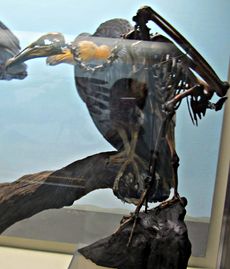
- العقاب الأوروپي ("Diatropornis") أواخر الإيوسيني/Early Oligocene –? Middle Oligocene of France[3]
- Phasmagyps Chadronian of Colorado.[3][4]
- Cathartidae gen. et sp. indet. (Late Oligocene of Mongolia)[3]
- Brasilogyps Late Oligocene – Early Miocene of Brazil[3]
- Hadrogyps ("American dwarf vulture") Middle Miocene of SW North America[3]
- Cathartidae gen. et sp. indet. Late Miocene/Early Pliocene of Lee Creek Mine, USA[5]
- Pliogyps ("Miocene vulture") Late Miocene – Late Pliocene of S North America[3]
- Perugyps ("Peruvian vulture)" Pisco Late Miocene/Early Pliocene of SC Peru[5]
- Dryornis ("Argetinean vulture") Early–Late? Pliocene of Argentina; may belong to modern genus Vultur[3]
- Cathartidae gen. et sp. indet. (Middle Pliocene of Argentina[5]
- Aizenogyps ("South American vulture") Late Pliocene of SE North America[3]
- Breagyps ("long-legged vulture)" Late Pleistocene of SW North America[3]
- Geronogyps Late Pleistocene of Argentina and Peru[3]
- Gymnogyps varonai late Quaternary of Cuba [6]
- Wingegyps ("Amazonian vulture") Late Pleistocene of Brazil [7]
- Cathartidae gen. et sp. indet. (Cuba)[8]
الوصف
عقبان العالم الجديد بشكل عام كبيرة الحجم، حيث يتراوح طولها ابتداء من العقاب الأصغر أصفر الرأس (Cathartes burrovianus) بطول 56 إلى 61 سنتمترا، وحتى كندور كاليفورنيا وكوندور الأنديز، والذين قد يصل طولهما إلى 120 سنتمترا ووزنهما إلى 12 كيلوجراما أو أكثر. يغلب على ريش هذه الطيور اللون الأسود أو البني، وتكون عليه أحيانا علامات بيضاء، وكل أنواع هذه الفصيلة لها رؤوس وأعناق خالية من الريش، ويكون جلدها أحيانا ملونا بشكل خفيف، أما في عقاب الملك فإن الجلد يكون على شكل زوائد وبروزات تبرز من الرأس.
لعقبان العالم الجديد جميعها أجنحة طويلة وعريضة وذيل قاسٍ ملائم للطيران المرتفع، وهذه العقبان هي الأفضل بين كل الطيور البرية طيرانا وتحليقا في الأماكن المرتفعة. أما أقدامها فهي معكوفة ولكن ضعيفة وغير مخصصة للافتراس والانقضاض على الفرائس كما تفعل العقبان، ومناقيرها معكوفة أيضا وضعيفة مقارنة بغيرها من الطيور الجارحة.
الانتشار والموئل
يعيش عقاب العالم الجديد في النصف الغربي من كوكب الأرض، ويمكن العثور عليه من جنوب كندا وحتى جنوب أمريكا، ومعظم أنواعها طيور مقيمة غير مهاجرة، إلا أن نسر البغاث الذي يتكاثر في كندا وشمال أمريكا يهاجر جنوبا في فصل الشتاء. ونسور العالم الجديد تقطن مواطن ونظما بيئية واسعة وممتدة، فهي تعيش في الصحاري والغابات الاستوائية وفي المناطق المرتفعة عن سطح البحر وفي السلاسل الجبلية، مستخدمة قوتها في حاسة الشم لتحديد أماكن الجيف، كما تشاهد هذه الطيور أحيانا في مناطق البشر، وربما تأتي إليها لتقتات على الحيوانات الميتة التي تموت دهسا على الطرقات.
السلوك والبيئة
التغذية

التكاثر
الحالة والحفاظ
في الثقافة
الهوامش
- ^ خطأ استشهاد: وسم
<ref>غير صحيح؛ لا نص تم توفيره للمراجع المسماةBirdLife-Int:2006 - ^ خطأ استشهاد: وسم
<ref>غير صحيح؛ لا نص تم توفيره للمراجع المسماةBLI - ^ أ ب ت ث ج ح خ د ذ ر Emslie (1988)
- ^ Wetmore, A. (1927). "Fossil Birds from the Oligocene of Colorado" (PDF). Proceedings of the Colorado Museum of Natural History. 7 (2): 1–14.
- ^ أ ب ت Stucchi (2005)
- ^ Suárez (2003)
- ^ Alvarenga (2004).
- ^ Suarez (2004)
المصادر
- Allaby, Michael (1992). The Concise Oxford Dictionary of Zoology. Oxford: Oxford University Press ISBN 0-19-286093-3, p. 348
- Alvarenga, H. M F. & S. L. Olson. (2004). "A new genus of tiny condor from the Pleistocene of Brazil (Aves: Vulturidae)." Proceedings of the Biological Society of Washington 117(1) 1 9
- American Ornithologists' Union (2009) Check-list of North American Birds, Tinamiformes to Falconiformes 7th Edition. AOU. Retrieved 6 October 2009
- American Ornithologists' Union (2010) Check-list of North American Birds, Tinamiformes to Falconiformes 7th Edition. AOU. Retrieved 3 August 2010
- Avise, J. C.; Nelson, W. S. & Sibley, C. G. (1994) "DNA sequence support for a close phylogenetic relationship between some storks and New World vultures" Proc. Natl. Acad. Sci. USA 91(11): 5173–5177. doi:10.1073/pnas.91.11.5173 (PDF). Erratum, PNAS 92(7); 3076 (1995). doi:10.1073/pnas.92.7.3076b
- BirdLife International (2004). 2001 Categories & Criteria (version 3.1). International Union for Conservation of Nature and Natural Resources. Retrieved 9 September 2007.
- BirdLife International (2009). Vultur gryphus. القائمة الحمراء للأنواع المهددة بالانقراض 2008. IUCN سنة 2008. تم استرجاعها في 6 October 2009.
- BirdLife International (2009a). Gymnogyps californianus. القائمة الحمراء للأنواع المهددة بالانقراض 2008. IUCN سنة 2008. تم استرجاعها في 6 October 2009.
- Brookes, Ian (editor-in-chief) (2006). The Chambers Dictionary, ninth edition. Edinburgh: Chambers. ISBN 0-550-10185-3.
{{cite book}}:|first=has generic name (help) p. 238 - Brown J. W. & D. P. Mindell (2009) "Diurnal birds of prey (Falconiformes)" pp. 436–439 in Hedges S. B. and S. Kumar, Eds. (2009) The Timetree of Life Oxford University Press. ISBN 019953503
- de Boer, L. E. M.(1975) "Karyological heterogeneity in the Falconiformes (Aves)" Cellular and Molecular Life Sciences 31(10): 1138–1139. doi:10.1007/BF02326755 PMID 1204722
- Campbell, Kenneth E. Jr. & Tonni, E. P. (1983): "Size and locomotion in teratorns" (PDF) Auk 100(2): 390–403
- Cracraft, J., F. K. Barker, M. Braun, J. Harshman, G. J. Dyke, J. Feinstein, S. Stanley, A. Cibois, P. Schikler, P. Beresford, J. García-Moreno, M. D. Sorenson, T. Yuri, and D. P. Mindell. (2004) "Phylogenetic relationships among modern birds (Neornithes): toward an avian tree of life." pp. 468–489 in Assembling the tree of life (J. Cracraft and M. J. Donoghue, eds.). Oxford University Press, New York.
- Emslie, Steven D. (1988) "An early condor-like vulture from North America" The Auk 105:3 529–535
- Ericson, Per G. P.; Anderson, Cajsa L.; Britton, Tom; Elżanowski, Andrzej; Johansson, Ulf S.; Kallersjö, Mari; Ohlson, Jan I.; Parsons, Thomas J.; Zuccon, Dario & Mayr, Gerald (2006): Diversification of Neoaves: integration of molecular sequence data and fossils. Biology Letters, in press. doi:10.1098/rsbl.2006.0523 PMID 17148284
- Farmer A, Francl, K (2008) Cathartes aura University of Michigan Animal Diversity Web. Retrieved 8 October 2009
- Feduccia, J. Alan. (1999) The Origin and Evolution of Birds Yale University Press ISBN 0-226-05641-4 p. 300
- Fisher, Harvey I. (1942) "The Pterylosis of the Andean Condor" Condor 44(1): 30–32.
- Gibb, G. C., O. Kardailsky, R. T. Kimball, E. L. Braun, and D. Penny. 2007. Mitochondrial genomes and avian phylogeny: complex characters and resolvability without explosive radiations. Molecular Biology Evolution 24: 269–280.
- Harris, Tim (2009). Complete Birds Of The World. Washington D.C: National Geographic Society. ISBN 978-1-4262-0403-6. p. 72
- DOI:10.1126/science.1157704 10.1126/science.1157704
This citation will be automatically completed in the next few minutes. You can jump the queue or expand by hand - Howell, Steve N.G., and Sophie Webb (1995). A Guide to the Birds of Mexico and Northern Central America. New York: Oxford University Press ISBN 0-19-854012-4, p. 174
- Kemp, Alan, and Ian Newton (2003): New World Vultures. In Christopher Perrins, ed., The Firefly Encyclopedia of Birds. Firefly Books. ISBN 1-55297-777-3. p. 146
- Krabbe, Niels & Fjeldså, Jon. 1990: Birds of the High Andes. Apollo Press ISBN 87-88757-16-1 p. 88
- Ligon, J. D. (1967): Relationships of the cathartid vultures. Occasional Papers of the Museum of Zoology, University of Michigan 651: 1–26.
- Mayr, G. (2006). "A new raptorial bird from the Middle Eocene of Messel, Germany." Historical Biology 18(2): 95–102
- Myers, P., R. Espinosa, C. S. Parr, T. Jones, G. S. Hammond, and T. A. Dewey. (2008) Family Cathartidae University of Michigan Animal Diversity Web Retrieved 5 October 2009
- Phillips, Steven J, Comus, Patricia Wentworth (Arizona-Sonora Desert Museum) (2000) A natural history of the Sonoran Desert University of California Press ISBN 0-520-21980-5 p,377
- Reed, Chester Albert (1914): The bird book: illustrating in natural colors more than seven hundred North American birds, also several hundred photographs of their nests and eggs. University of Wisconsin. p. 198
- Remsen, J. V., Jr., C. D. Cadena, A. Jaramillo, M. Nores, J. F. Pacheco, M. B. Robbins, T. S. Schulenberg, F. G. Stiles, D. F. Stotz, and K. J. Zimmer. A classification of the bird species of South America. American Ornithologists' Union.
- Ryser Fred A. & A. Ryser, Fred Jr. 1985: Birds of the Great Basin: A Natural History. University of Nevada Press. ISBN 0-87417-080-X p. 211
- Sibley, Charles G. and Burt L. Monroe (1990) Distribution and Taxonomy of the Birds of the World. Yale University Press. ISBN 0-300-04969-2
- Sibley, Charles G., and Jon E. Ahlquist (1991) Phylogeny and Classification of Birds: A Study in Molecular Evolution. Yale University Press. ISBN 0-300-04085-7
- Snyder, Noel F. R. & Snyder, Helen (2006). Raptors of North America: Natural History and Conservation. Voyageur Press. ISBN 0-7603-2582-0 p. 40
- Stone, Lynn M. (1992) Vultures Rourke Publishing Group ISBN 0-86593-193-3 p. 14
- (بالإسپانية) Stucchi, Marcelo; Emslie Steven D. (2005) "Un Nuevo Cóndor (Ciconiiformes, Vulturidae) del Mioceno Tardío-Plioceno Temprano de la Formación Pisco, Perú." The Condor 107:(1) 107 113 DOI:10.1650/7475
- Suárez, W.; Emslie, S.D. (2003). "New fossil material with a redescription of the extinct condor Gymnogyps varonai (Arredondo, 1971) from the Quaternary of Cuba (Aves: Vulturidae)" (PDF). Proceedings of the Biological Society of Washington. 116 (1): 29–37.
- Suarez, William (2004) "The identity of the fossil raptor of the genus Amplibuteo (Aves: Accipitridae) from the Quaternary of Cuba" Caribbean Journal of Science 40: (1) 120 125
- Terres, J. K. & National Audubon Society (1991). The Audubon Society Encyclopedia of North American Birds. Reprint of 1980 edition. ISBN 0-517-03288-0 p 957
- Tozzer, Alfred Marston & Allen, Glover Morrill (1910). Animal Figures in the Maya Codices. Harvard University Plates 17 & 18
- Wink, M. (1995): Phylogeny of Old and New World vultures (Aves: Accipitridae and Cathartidae) inferred from nucleotide sequences of the mitochondrial cytochrome b gene. Zeitschrift für Naturforschung 50 (11–12): 868–882.
- Zim, Herbert Spencer; Robbins, Chandler S.; Bruun, Bertel (2001) Birds of North America: A Guide to Field Identification Golden Publishing. ISBN 1-58238-090-2
. . . . . . . . . . . . . . . . . . . . . . . . . . . . . . . . . . . . . . . . . . . . . . . . . . . . . . . . . . . . . . . . . . . . . . . . . . . . . . . . . . . . . . . . . . . . . . . . . . . . . . . . . . . . . . . . . . . . . . . . . . . . . . . . . . . . . . . . . . . . . . . . . . . . . . . . . . . . . . . . . . . . . . . .
وصلات خارجية
- New World Vulture videos, photos and sounds on the Internet Bird Collection
- New World Vulture sounds on xeno-canto.org
